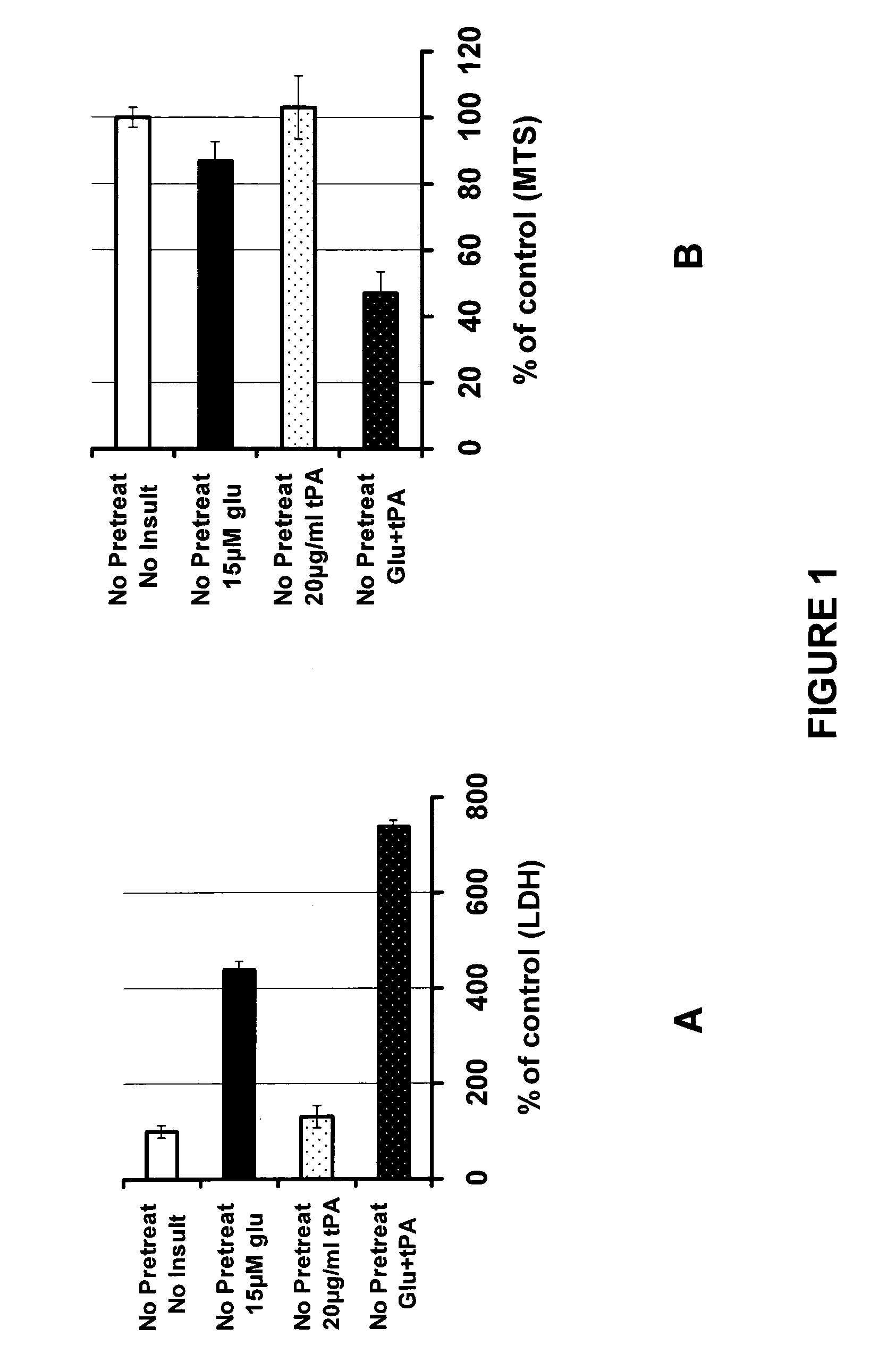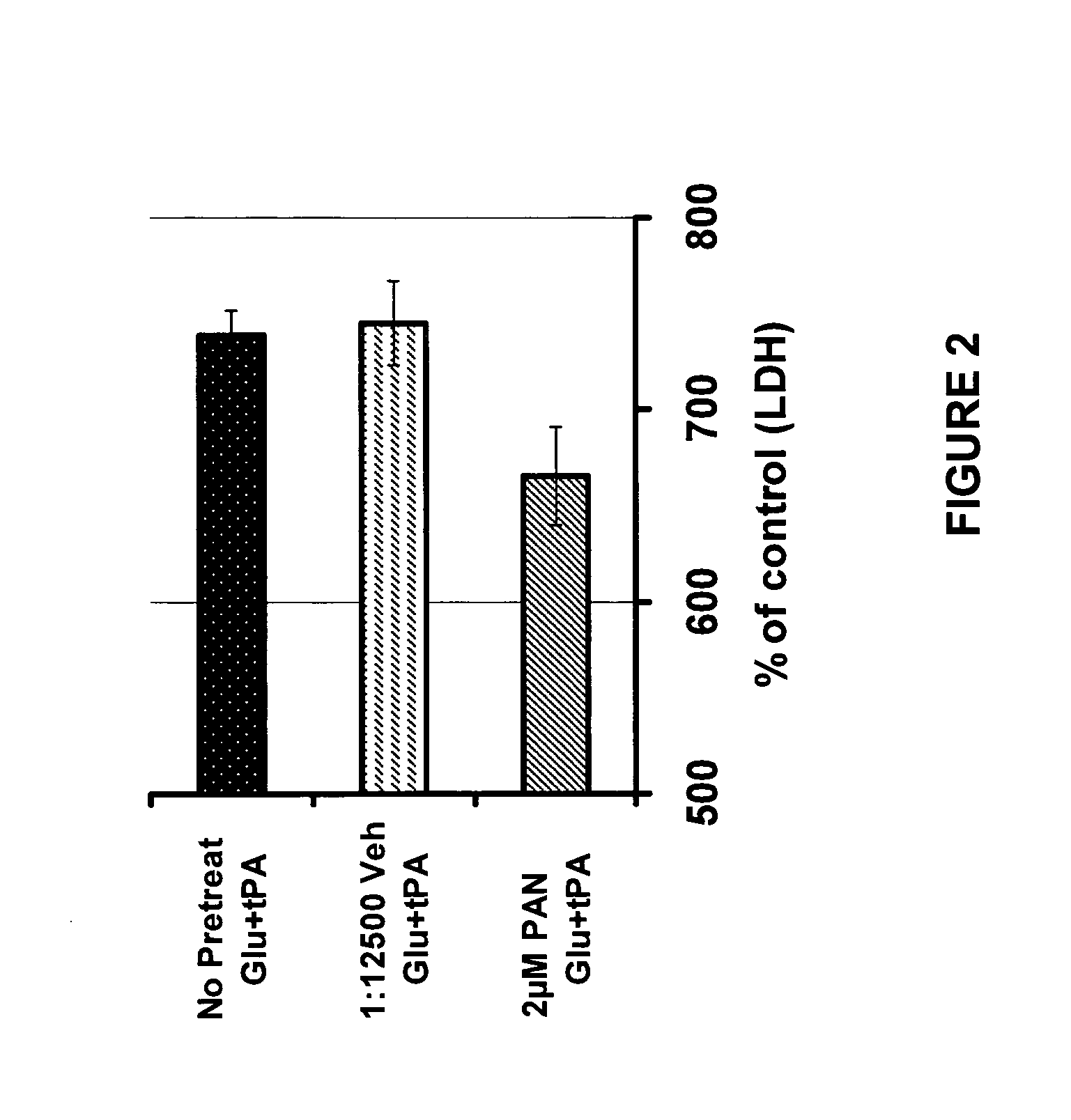Composition and method to inhibit tissue plasminogen activator (tPA) - potentiated neurotoxicity
a tissue plasminogen activator and neurotoxicity technology, applied in the field of compounding and modifying the ability of tissue plasminogen activators to inhibit tissue plasminogen activators (tpa) to achieve potentiated neurotoxicity, can solve the problems of stroke, significant burden on public health worldwide, and inability to provide direct neuroprotective drugs. stroke therapy is not approved for the purpose of stroke treatmen
- Summary
- Abstract
- Description
- Claims
- Application Information
AI Technical Summary
Benefits of technology
Problems solved by technology
Method used
Image
Examples
example 1
PAN-811 Suppresses tPA-Potentiated Neurotoxicity Resulted from Glutamate Insult
[0048]For this example PAN-811 was dissolved in PEG:EtOH (7:3) to a concentration of 25 mM, and further diluted in neurobasal medium to a final concentration of 2 μM. The control vehicle is 1:12,500 PEG:EtOH (7:3 in BSS).
[0049]A mixed culture of embryonic (E18) rat cortical and striatal neurons was cultured for 22 days in 50% antioxidative (AO) neurobasal medium (made by replacing 50% of the neurobasal culture medium with a medium comprised of neurobasal plus B27 supplement (minus AO, i.e., without the antioxidants vitamin E, vitamin E acetate, 2.5 mg / L superoxide dismutase, 2.5 mg / L catalase, and 1 mg / L glutathione) (from Invitrogen)), and then divided into test groups in accordance with the following scheme: (1) not insulted (control); (2) insulted with 15 μM glutamate; (3) insulted with 20 μg / ml tPA; or (4) insulted with both 15 μM glutamate and 20 μg / ml tPA, for a period of 24 hours. In a further test...
example 2
PAN-811 Significantly Inhibits tPA-Potentiated Neurotoxicity Resulting from Ischemic Insult
[0056]In this example, PAN-811 was dissolved in PEG:EtOH (7:3) to a concentration of 25 mM, and further diluted in neurobasal medium to final concentrations of 1.25, 2.5, 5 and 10 μM. The control vehicle is 1:10,000 PEG:EtOH (7:3 in BSS).
[0057]A mixed culture of embryonic (E18) rat cortical and striatal neurons was cultured for 13 days in neurobasal medium (Invitrogen), then insulted by hypoglycemia / hypoxia (H / H) conditions for 6 hours, or a combination of H / H and 20 μg / ml tPA. The H / H conditions were 1.2 mM glucose (normally 25 mM in culture medium) and the absence of oxygen for 6 hours. (Following H / H conditions, the cultures were returned to the typical conditions of 25 mM glucose medium and 95% ambient air plus 5% CO2.)
[0058]In a further experiment, cells that were under H / H conditions and also treated with the tPA were divided into groups, which were either co-treated or post-treated (i.e...
PUM
 Login to View More
Login to View More Abstract
Description
Claims
Application Information
 Login to View More
Login to View More - R&D
- Intellectual Property
- Life Sciences
- Materials
- Tech Scout
- Unparalleled Data Quality
- Higher Quality Content
- 60% Fewer Hallucinations
Browse by: Latest US Patents, China's latest patents, Technical Efficacy Thesaurus, Application Domain, Technology Topic, Popular Technical Reports.
© 2025 PatSnap. All rights reserved.Legal|Privacy policy|Modern Slavery Act Transparency Statement|Sitemap|About US| Contact US: help@patsnap.com



